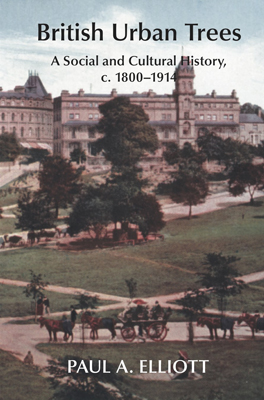British Urban Trees
A Social and Cultural History, c. 1800–1914

Paul A. Elliott
GREENING THE VICTORIAN URBAN WORLD
Whether we consider the great London Planes which are now the largest trees in many British urban streets, the exotic ornamentals from across the globe flourishing in numerous private gardens, the stately trees of public parks and squares or the dense colourful foliage of suburbia, the impact of trees and arboriculture upon modern towns and their ecosystems is clear. From the formal walks and squares of the Georgian town to Victorian tree-lined boulevards and commemorative oaks, trees are the organic statuary of modern urban society, providing continuity yet constantly changing through the day and over the seasons. Interfacing between humans and nature, connecting the continents and reaching back and forward through time to past and future generations, they have come to define urbanity while simultaneously evoking nature and the countryside. This book is the first major study of British urban arboriculture between 1800 and 1914 and draws upon fresh approaches in geographical, urban and environmental history. It makes a major contribution to our understanding of where, how and why trees grew in British towns in the period, the social and cultural impact of these and the attitudes taken towards them.
LOOK INSIDE THIS BOOK at Amazon.co.uk
THE AUTHOR
Paul A. Elliott is Professor of Modern History in the College of Law, Humanities and Social Sciences at the University of Derby. His research interests include the history of science, local, urban and regional history, historical geography, landscape history and the history of education. His books include The Derby Philosophers: Science and Culture in English Urban Society, 1700–1850 (MUP, 2009), Enlightenment, Modernity and Science: Geographies of Scientific Culture in Eighteenth Century England (I.B. Tauris, 2010) and (as co-author) The British Arboretum: Trees, Science and Culture in the Nineteenth Century (Pickering and Chatto, 2011). He has published numerous articles in leading national and international history and geography journals including Isis, British Journal for the History of Science, History of Education, Social History, Garden History, Annals of Science, Urban History, Notes and Records of the Royal Society of London, Studies on Voltaire and the Eighteenth Century, Journal of Historical Geography and Midland History.
‘With his detailed focus on the thoughts and aspirations of the treeplanters of the Victorian era Elliott has done a great service to the study of urban environmental history.’
Henry W. Lawrence – Journal of Historical Geography
‘a definitive monograph on how and why trees became so important to British cities in the nineteenth century.’
Charles E. Closmann – Journal of Urban History
‘This book is a very useful, heavily illustrated account of trees and tree-planting in British cities during the nineteenth century. It combines recent research on the history of gardening and arboriculture, as well as urban and environmental approaches. Though heavily concerned with Victorian parks and the creation of arboreta, as well as villa gardens, Paul Elliot has fascinating things to say on tree-lined streets, cemeteries, hospitals, and other green spaces.’
Peter Clark – Europe Now
‘Readers interested in urban trees and urban greenspace will find an abundance of information in this book.’
Jim Clifford – Environmental History
CONTENTS
Chapter One. Private Urban Garden Trees
Chapter Two. Trees in Public Parks and Gardens
Chapter Three. Trees in the Victorian Cemetery
Chapter Four. Trees in Victorian Nottingham c. 1840–1880
Chapter Five. Victorian and Edwardian Glasgow
Chapter Six. Towards a National Capital: Cardiff
Chapter Seven. Urban Trees and Smoke Pollution
Chapter Eight. Trees for Heath and Pleasure: Spa and Resort Towns
Publication date: 1 May 2016, 400pp. Black and white illustrations and diagrams
ISBN 9781-874267-904 (HB) £65
